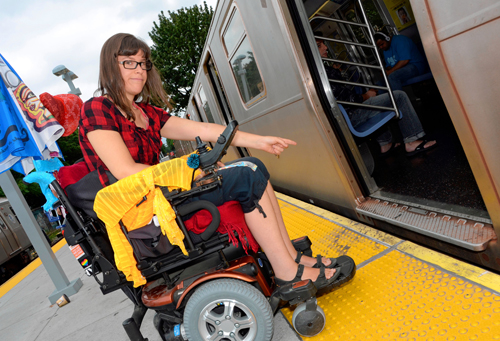Disabled Activist Says ‘Accessible’ Stations are Not Always So

Michele Kaplan, a wheelchair-bound subway patron is not happy with the space between the train and the platform in many of Brooklyn’s supposedly ‘wheelchair accessible’ stations. Kaplan notes that she often gets stuck in gaps that are simply too steep in many stations which are touted as ‘accessible,’ leaving her feeling frightened and vulnerable and in need of assistance.
“It is an incredibly scary experience, and I am pretty fearless in my chair,” said Kaplan.
Kaplan has been documenting her experiences in New York’s subways in her blog http://mindthegapmta.tumblr.com/ where she is trying to raise awareness of her plight and that of upwards of 60,000 subway users who she says are constantly confronting the dangerous and scary gaps between the trains and the platforms.
Kaplan is not the only one complaining, either. Advocates for the rights of the disabled say that there are lots of problems in the system, including at what are labeled as “wheelchair-friendly” stations, including Borough Hall, Atlantic Avenue–Barclays Center, DeKalb Avenue, and the Kings Highway B and Q stop, to name just a few.
According to the “Americans with Disabilities Act” there is a legal limit to the gap between train and platform, namely 5/8 of an inch. Anything beyond that is breaking the law. At the Borough Hall station the gap can be as much as three inches, says Martin Coleman, a disabled rights lawyer and an outspoken critic of the Metropolitan Transportation Authority.
“It’s breaking the law,” Coleman says. “This is a situation they know about, and they will not take steps to address it.”
On the Long Island Railroad MTA workers assist passengers who cannot negotiate the dangerous gaps on their own. They even have ‘gap-flaps,’ sturdy ramps to put down at especially troublesome stations. This assistance was instituted after the fatal accident of 18-year-old Natalie Smead in August of 2006 in Queens. But New York City subways are not the LIRR.
“There should be no need for assistance” at “accessible” stations, says Deidre Parker of the MTA. As long as the disabled rider comes in and exits the train at the specified zones which are clearly marked with signs.
Conductors on trains are allowed to help people if they want to, but only at 19 “accessible” stations out of 157 in Brooklyn.
“It is important to note that not every station can be modified to permit [Americans with Disabilities Act] compliant gap tolerances at every train door,” Parker said.
But that news is no comfort for Kaplan, who started a petition begging the MTA to shrink the gaps.
“This is an issue of safety,” the petition notes. “If the MTA lists a station as ‘Wheelchair Accessible’ then it needs to be wheelchair accessible, but it’s not consistently so.”
